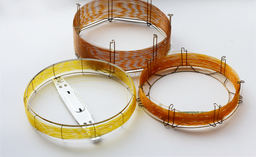Graphene as a Stationary Phase in Gas Chromatography
TECHNOLOGY NUMBER: 2022-128

OVERVIEW
Improved methodology for gas chromatography (GC) systems- Greater control over run times, peak shapes, eluent order
- Electronic tuning of binding energy without heating
BACKGROUND
Gas chromatography (GC) is a ubiquitous analytical technique, used widely in environmental, industrial, biomedical, forensics, and research applications. GC instrumentation relies on the interaction of mobile vapor molecules traveling through a column coated with a stationary phase. Separation of analytes in a sample is achieved due to the varying strengths of interaction of each analyte with the stationary phase, resulting in varying elution times. In many applications, it is desirable to adjust the interaction ("binding energy") between the vapor molecules and the stationary phase, often mid-run of the sample. Doing so can decrease the run time of the sample, increase the number of eluent peaks collected, sharpen and correct peak shape. Currently, heating of the stationary phase is the most common method for adjusting the binding energy. Disadvantages of this method include greater power use, long cool-down times, and more complicated circuitry.
INNOVATION
Researchers at the University of Michigan have developed a GC system that utilizes graphene as the stationary phase and is particularly suitable for microGCs. Graphene inherently displays varying binding energies with various vapor molecules, which leads to separation of those vapor molecules. By configuring graphene into a field effect transistor (FET) design, the molecule-graphene interaction can be tuned by adjusting the graphene Fermi level through the FET gate voltage. This allows greater control over the elution time and/or elution order of vapor molecules in the sample. This GC design has several advantages. Compared to polymer-based stationary phases, the graphene stationary phase has higher chemical robustness without bleed issues. Electronic tuning of the binding energy requires far less electrical power than heating, is more responsive, and does not require lengthy cool down periods between sample runs. The graphene GC is smaller, portable, and able to operate at a low temperature.